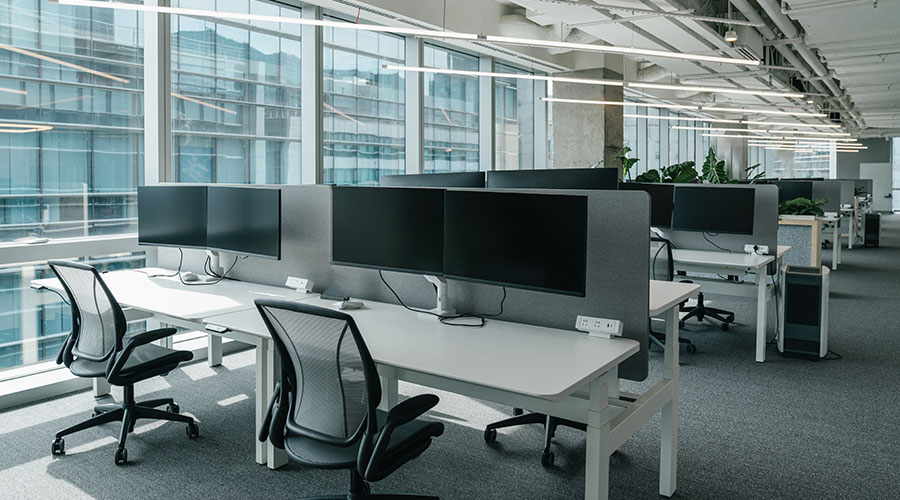Lighting Part I: Recycling Revisited
Growing scrutiny of lamp and ballast disposal pushes the issue higher on managers’ list of compliance priorities
Institutional and commercial facilities of all types are under pressure to comply with federal and state regulations governing the handling and disposal of hazardous materials. Increasingly, this effort is leading to greater scrutiny for lamps and ballasts.
Aside from understanding the issues surrounding lamp and ballast disposal, maintenance and engineering managers also must know about the availability of recycling and disposal options so they can develop guidelines for selecting the most appropriate options to avoid compliance problems.
Lamp Disposal
More than 600 million fluorescent lamps tubes are disposed of annually in the United States. Before June 1999, the U.S. Environmental Protection Agency (EPA) required that spent fluorescent lamps that did not pass a federal toxicity characteristic leaching procedure (TCLP) be treated as hazardous waste because they contained more than 0.2 mg/liter — parts per million (PPM) — of mercury.
Standard fluorescent lamps do not pass the TCLP test. Before the universal waste rule (UWR), these products had to be either handled as hazardous waste or recycled by using expensive hazardous-waste haulers and massive documentation.
The UWR now covers fluorescent lamps. The main purpose of including fluorescent lamps in the UWR is to encourage users to recycle spent lamps. Users of TCLP-compliant lamps, however, have disposal options in most states that allow them to control disposal costs. For more information on the UWR, see the article below.
Lamp manufacturers have reduced the mercury content of fluorescent tubes over the past decade to less than one-half of the original levels. In response to public concerns related to environmental harm from mercury, major lamp manufacturers started to produce lamps they originally called low-mercury lamps. These lamps now are called TCLP-compliant lamps to indicate they are designed to pass the TCLP test. Low-mercury lamps have distinctive colored end caps, usually green.
TCLP-compliant lamps provide end users in facilities with normal lamp performance, light output and lamp life, as well as an environmentally friendly option to meeting lighting needs. Although these lamps do not need to be recycled, many end users avoid any liability from lamp disposal by recycling spent TCLP-compliant lamps.
Ballast Disposal
The replacement rate of ballasts has increased as users have converted to more efficient fluorescent systems through the use of electronic ballasts.
Magnetic ballasts made before 1979 might contain polychlorinated biphenols (PCBs). Manufacturers used PCBs as a dielectric in ballast capacitors, and each ballast contains about 1 ounce of PCB. Over time, PCBs can leach out of the capacitor.
Since ballast life can extend to more than 25 years, an environmental problem exists in facilities that requires managers’ attention for at least several more years. To identify ballasts that have PCBs, managers must read the ballast label to determine if it has a “No PCBs” message. A ballast probably contains PCBs if it has no such message and if its date code indicates it was manufactured before 1979.
Beginning in 1979, some ballast manufacturers used ballast capacitors with another toxic dielectric — diethyl hexyl phthalates (DEHP). EPA also lists DEHP as a hazardous substance. Ballasts with either PCBs or DEHPs should not be retired in place because they could pose a future liability issue for facilities. Instead, managers need to ensure their disposal in accordance with federal and local environmental laws or have them recycled by a licensed recycler.
PCBs and DEHPs
The Toxic Substances Control Act (TSCA) prohibits the manufacture, processing, use and distribution of PCBs. TSCA provides for disposal in a sanitary landfill if a ballast capacitor is intact and not leaking.
But if the capacitor is leaking, the ballast must be disposed of in a chemical landfill after the liquid is drained. Practically, the cost of a laboratory test to determine a capacitor’s condition is apt to be higher than the recycling cost. The ballast recycler must be a TOSCA-approved disposal facility with a commercial storage permit.
The Comprehensive Environmental Response Compensation and Liability Act (CERCLA) regulates both PCBs and DEHPs as hazardous substances. CERCLA requires notification to proper authorities if more than 1 pound — about 16 ballasts — is disposed of at one time. Generators of PCB-containing ballasts can incur liability for improperly disposing of PCB ballasts in a Dumpster or landfill.
Finally, the U.S. Department of Transportation regulates the safe transport of hazardous chemicals on federal highways. Ballasts must be packed in standard drums and marked with a Class 9 label and may be transported by common carriers in most states. But a number of state laws require use of hazardous-materials haulers.
Making a Decision
More than 20 states regulate lighting ballasts to varying degrees. For example, Wisconsin allows 32 ballasts per project in a sanitary landfill. Disposing of more than 32 ballasts in the state requires incineration or the use of a chemical landfill.
Managers can dispose of ballasts in a sanitary landfill, a chemical-waste landfill, or a high-temperature incinerator, or they can recycle the ballasts. To properly recycle ballasts, managers need to contact an authorized recycler.
The facility generating the spent ballasts must pack them in 50-gallon drums and label them properly. Workers should handle these ballasts with disposable gloves, which they also should place in the drums.
The recycler then picks up the drums at the generator’s facility and dismantles them at the recycling center, at the same time separating the steel cases, steel laminations, copper or aluminum wire, capacitors, and potting compound.
Finally, the recycler places capacitors and potting compound in drums marked with labels indicating that they contain hazardous materials and sends the drums to a high-temperature incinerator for destruction.
Proper disposal of lamps and ballasts is becoming a higher priority for institutional and commercial facilities as public concerns over pollution evolve. Savvy managers will make a point to keep abreast of both advances related to disposal options and changes in regulatory requirements.
A Closer Look at UWR
Fluorescent lamps are considered spent when they are removed after their service life. Lamps that contain materials listed as hazardous waste, such as mercury and lead, by the U.S. Environmental Protection Agency (EPA) are considered hazardous waste.
Universal wastes include items such as batteries, thermostats and obsolete pesticides. In 1999, the Universal Waste Rule (UWR) added hazardous-waste lamps to the federal list of universal wastes regulated under the Resource Conservation and Recovery Act (RCRA). It also reduced the regulatory burden on generators for collection, storage and transport. End users in institutional and commercial facilities still must comply fully with recycling, treatment and disposal requirements.
The EPA concluded that regulating spent hazardous-waste lamps as universal waste would lead to better management and facilitate compliance with hazardous-waste requirements. A generator or third party that accumulates up to about 11,000 pounds of universal waste on site is defined as a small-quantity handler (SQH) and may store this maximum amount on site for up to one year.
An SQH does not have to manifest shipments but must mark shipping containers to comply with requirements of the U.S. Department of Transportation. They must label waste lamps “Universal Waste – Lamps,” not “Hazardous Waste,” and they must ship the lamps to another handler or to a destination facility.
Under UWR’s provisions, states are not required to adopt less-stringent regulations because a number of states adopted UWR for spent lamps before the EPA’s action. If a state’s standards for spent lamps are less stringent than those for UWR, the state had to amend its regulations to make them equivalent to UWR standards.
Handling Waste
Universal-waste handlers and transporters may crush hazardous-waste lamps but only to reduce their volume and only at the site where the lamps are generated. As a practical matter, unless engineering and maintenance managers want to create an area similar to one used for asbestos abatement, for example, it might make more sense to send lamps to a recycler intact.
Lamp crushing must be done in a well-ventilated, monitored and closed system designed and operated to prevent mercury vapors from exceeding 0.1 mg/cubic meter — a time-weighted average in an eight-hour period. Lamps must be stored in closed, non-leaking containers, and the state EPA office must be notified.
Finally, employees who handle universal-waste lamps must be thoroughly familiar with emergency procedures. Even when following UWR regulations for crushing, the process can pose health risks if enough mercury vapors are released.
|
Recycling Resources
The issue of lamp and ballast disposal has become a higher priority as a result of greater public scrutiny and changing laws. Engineering and maintenance managers seeking more information on this evolving issue can check out these organizations and resources:
|
Related Topics:











